#Music Influencer in india
Text
Music, the universal language of emotions, holds the power to heal and inspire. In today’s digital age, music influencers are at the forefront, showcasing their unique styles and connecting with audiences worldwide. From singers to composers, these influencers navigate diverse genres, captivating listeners and setting trends in the ever-evolving music scene. Here’s a handpicked selection of the top 4 music influencers who are making waves and setting the stage for 2024.
Sumonto Mukherjee
Starting his musical training in Hindustani Classical music during his early childhood, Sumonto has crafted his musical journey from being selected for Saregamapa Lil Champs to becoming a music influencer with his viral music covers. He has become a household name in the music industry, boasting more than 450k followers on Instagram and over 270k views on ‘Khair Mangda’, showcasing his ability to captivate audiences and make them groove to his beat.
Gravero
Sourav Ray is popularly known for creating mashups, and one of his recent trending mashups is ‘Husn X Let her go’ with millions of views. He is known for producing Lofi mashups to originals. His deep understanding of music and passion to create it in such a way that it touches every soul and resonates with every listener. His talent, hard work, and dedication have paved the way for him to achieve his dreams and goals in life.
Mihika Sansare
Mihika Sansare is popularly known for creating music covers in her unique style and posting them across social media platforms to entertain and engage with her audience. She is a guitarist and a singer with 250k+ followers on Instagram and 600k+ subscribers on YouTube. One of her covers – ‘Tumhe jo maine dekha’ has garnered more than one million views.
Vasu Kainth
Vasu Kainth is a singer, composer, and a songwriter. He has a huge fanbase with 90k+ followers on Instagram and 200k+ subscribers on YouTube. From original songs to mashup videos, he is creating music in a unique way to connect with his audience. He even got the opportunity to collaborate with other renowned musicians from the industry, that feels like a dream come true. From classical roots to innovative mashups and soulful covers, every artist has carved their unique style, resonating with audiences globally. Music influencers have turned social media platforms into their new stage, where they can entertain and connect with their audience.
#Infliencer Marketing Agency#Influencer Marketing Agency in India#Content Creator#Music Influencer#Music Influencer in india
0 notes
Text
Fast Life
Mood board
Chapters
1.
2.
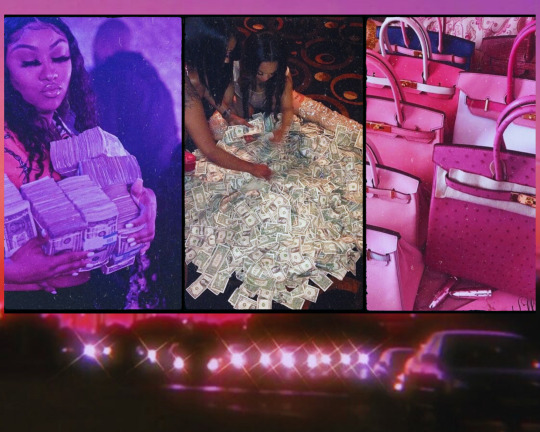

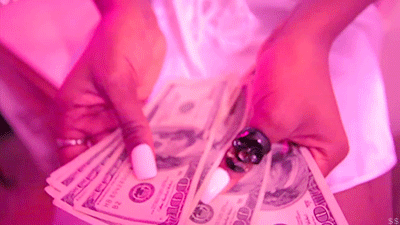

Money,
Clothes,
Cars,
&
Diamonds
That fast life catches up to you…
#aesthetic#black girl fashion#beauty#fashion#ari fletcher#dreamdoll#india love#clermont twins#instagram#moodboard#Instagram models#influencer#money#atlanta#pretty girls like trap music#hustler#trap#fanfiction#smut#Spotify
12 notes
·
View notes
Text
Escaped Prisoner Prank
4K
youtube
#trending viral instagram love explorepage explore instagood fashion follow tiktok like likeforlikes followforfollowback#photography india trend instadaily memes music style trendingnow reels foryou likes photooftheday model#beautiful bollywood bhfyp instaviralvideos fyp viralpost beauty kerala picoftheday dance art cute#mumbai funny onlineshopping foryoupage comment fashionblogger youtube meme trendy nature followme lifestyle tamil#life photoshoot reelsinstagram new motivation funnymemes instafashion sharefyp foryou viral explorepage#prank pranks funny memes viral comedy tiktok funnyvideos prankvideo prankindonesia meme prankster lol#funnymemes love funnypranks dagelan prankwars videolucu fun video pranksgonewrong ngakakkocak instagram#trending like ngakak follow youtube pranksterslucu prankvideos humor instagood prankinvasion prankkissing#youtuber youtube youtubechannel youtubers instagram subscribe love follow like gamer music vlogger tiktok gaming instagood#explorepage trending sub youtubevideos viral influencer explore video blogger vlog photography twitch memes youtubevideo k#contentcreator ps likeforlikes fashion streamer followforfollowback musician dance art myself funny model bhfyp bass dj like#likes makeup musicproducer musically twitchstreamer songs instadaily smallyoutuber fortnite bassboosted bgm beauty trap party#Youtube
3 notes
·
View notes
Text
#music pr#ai with pr#ai#artist#media outreach#audience#influencer#data#campaign#reputation management#social media#pr agency in noida#best pr agency in india#pr agency#best pr agencies in india#public relations#pr agencies in noida#pr agency for startups in india#best pr agencies in noida#pr
1 note
·
View note
Text




Buy Boat Wired Earphones Online at Best Prices In India
Buy Boat Wired Earphones at India's Best Online Shopping Store. Check Price in India and Shop Online. Free Shipping Cash on Delivery Best Offers
#boathead#music#boatheadphones#boat#plugintonirvana#headphones#boatnirvana#boatheads#whatsyournirvana#iamaboathead#boatlifestyle#sports#fitlife#lifestyleblogger#influencer#wirelessheadphones#fashionblogger#india#playwithboat#sportsgirl#gametime#fitnessblogger#wirelessbluetoothheadsets#boatrockerz#onlineshopping#shopping
1 note
·
View note
Text
South Asian and Hindu Influences in ATLA (Part 2)
disclaimer: i was raised culturally and religiously hindu, and though i've tried to do my research for this post and pair it with my own cultural knowledge, i'm not an expert on hinduism by any means. should i mess up, please let me know.
please also be aware that many of the concepts discussed in this post overlap heavily with religions such as buddhism and jainism, which might have different interpretations and representations. as i'm not from those religions or cultures, i don't want to speak on them, but if anyone with that knowledge wishes to add on, please feel free.
Part 1
In the previous post, I discussed some of the things ATLA got right in its depictions of desi and hindu cultures. unfortunately, they also got plenty of things wrong - often in ways that leaned towards racist caricatures - so let's break them down, starting with...
Guru Pathik
both the word "guru" and name "pathik" come from sanskrit. pathik means "traveler" or "he who knows the way" while guru is a term for a guide or mentor, similar to a teacher.
gurus were responsible for the very first education systems in ancient india, setting up institutions called gurukuls. students, referred to as disciples, would often spend years living with and learning from their gurus in these gurukuls, studying vedic and buddhist texts, philosophy, music and even martial arts.
however, their learning was not limited merely to academic study, as gurus were also responsible for guiding the spiritual evolution of their disciples. it was common for disciples to meditate, practice yoga, fast for days or weeks, and complete mundane household chores every day in order to instill them with self-discipline and help them achieve enlightenment and spiritual awareness. the relationship between a guru and his disciple was considered a sacred, holy bond, far exceeding that of a mere teacher and student.
aang's training with guru pathik mirrors some of these elements. similar to real gurus, pathik takes on the role of aang's spiritual mentor. he guides aang in unblocking his chakras and mastering the avatar state through meditation, fasting, and self-reflection - all of which are practices that would have likely been encouraged in disciples by their gurus.
pathik's design also takes inspiration from sadhus, holy men who renounced their worldly ties to follow a path of spiritual discipline. the guru's simple, nondescript clothing and hair are reflective of the ascetic lifestyle sadhus are expected to lead, giving up material belongings and desires in order to achieve spiritual enlightenment and, ultimately, liberation from the reincarnation cycle.
unfortunately, this is where the respectful references end because everything else about guru pathik was insensitive at best and stereotypical at worst.
it is extremely distasteful that the guru speaks with an overexaggerated indian accent, even though the iranian-indian actor who plays him has a naturally british accent. why not just hire an actual indian voice actor if the intention was to make pathik sound authentic? besides, i doubt authenticity was the sole intention, given that the purposeful distortion of indian accents was a common racist trope played for comedy in early 2000s children's media (see: phineas and ferb, diary of a wimpy kid, jessie... the list goes on).
furthermore, while pathik is presented a wise and respected figure within this episode, his next (and last) appearance in the show is entirely the opposite.

in the episode nightmares and daydreams, pathik appears in aang's nightmare with six hands, holding what appears to be a veena (a classical indian music instrument). this references the iconography of the hindu deity Saraswati, the goddess of wisdom and knowledge. the embodiment of divine enlightenment, learning, insight and truth, Saraswati is a member of the Tridevi (the female version of the Trimurti), one of the most respected and revered goddesses in the Hindu pantheon... and her likeness is used for a cheap laugh on a character who's already treated as a caricature.
that's bad enough on its own, but when you consider that guru pathik is the only explicitly south asian coded character in the entire show, it's downright insulting. for a show that took so many of its foundational concepts from south asia and hinduism and yet provided almost no desi representation in return, this is just rubbing salt in the wound.
Chakras
"chakra", meaning "circle" or "wheel of life" in sanskrit, refers to sources of energy found in the human body. chakra points are aligned along the spine, with energy flowing from the lowest to the highest point. the energy pooled at the lowest chakra is called kundalini, and the aim is to release this energy to the highest chakra in order to achieve spiritual enlightenment and consciousness.
the number of chakras varies in different religions, with buddhism referencing five chakras while hinduism has seven. atla draws from the latter influence, so let's take a look at the seven chakras:
Muladhara (the Root Chakra). located at the base of the spine, this chakra deals with our basest instincts and is linked to the element of earth.
Swadhisthana (the Sacral Chakra). located just below the navel, this chakra deals with emotional intensity and pleasure and is linked to the element of water.
Manipura (the Solar Plexus Chakra). located in the stomach, this chakra deals with willpower and self-acceptance and is linked to the element of fire.
Anahata (the Heart Chakra). located in the heart, this chakra deals with love, compassion and forgiveness and is linked to the element of air. in the show, this chakra is blocked by aang's grief over the loss of the air nomads, which is a nice elemental allusion.
Vishudda (the Throat Chakra). located at the base of the throat, this chakra deals with communication and honesty and is linked to the fifth classical element of space. the show calls this the Sound Chakra, though i'm unsure where they got that from.
Ajna (the Third Eye Chakra). located in the centre of the forehead, this chakra deals with spirituality and insight and is also linked to the element of space. the show calls it the Light Chakra, which is fairly close.
Sahasrara (the Crown Chakra). located at the very top of the head, this chakra deals with pure cosmic consciousness and is also linked to the element of space. it makes perfect sense that this would be the final chakra aang has to unblock in order to connect with the avatar spirit, since the crown chakra is meant to be the point of communion with one's deepest, truest self.
the show follows these associations and descriptions almost verbatim, and does a good job linking the individual chakras to their associated struggles in aang's arc.
Cosmic Energy
the idea of chakras is associated with the concept of shakti, which refers to the life-giving energy that flows throughout the universe and within every individual.
the idea of shakti is a fundamentally unifying one, stating that all living beings are connected to one another and the universe through the cosmic energy that flows through us all. this philosophy is referenced both in the swamp episode and in guru pathik telling aang that the greatest illusion in the world is that of separation - after all, how can there be any real separation when every life is sustained by the same force?
this is also why aang needing to let go of katara did not, as he mistakenly assumed, mean he had to stop loving her. rather, the point of shedding earthly attachment is to allow one to become more attuned to shakti, both within oneself and others. ironically, in letting go of katara and allowing himself to commune with the divine energy of the universe instead, aang would have been more connected to her - not less.
The Avatar State
according to hinduism, there are five classical elements known as pancha bhuta that form the foundations of all creation: air, water, earth, fire, and space/atmosphere.
obviously, atla borrows this concept in making a world entirely based on the four classical elements. but looking at how the avatar spirit is portrayed as a giant version of aang suspended in mid-air, far above the earth, it's possible that this could reference the fifth liminal element of space as well.
admittedly this might be a bit of a reach, but personally i find it a neat piece of worldbuilding that could further explain the power of the avatar. compared to anyone else who might be able to master only one element, mastering all five means having control of every building block of the world. this would allow the avatar to be far more attuned to the spiritual energy within the universe - and themselves - as a result, setting in motion the endless cycle of death and rebirth that would connect their soul even across lifetimes.
#atla#atla cultural influences#hinduism in atla#welp i thought this would be the last part but i ended up having more to talk about than i thought#so i'll save the book 3 inspirations for the next post#including my absolute favourite combustion man#and by favourite i mean kill it with fire why did you ever think this was okay to do writers
481 notes
·
View notes
Text
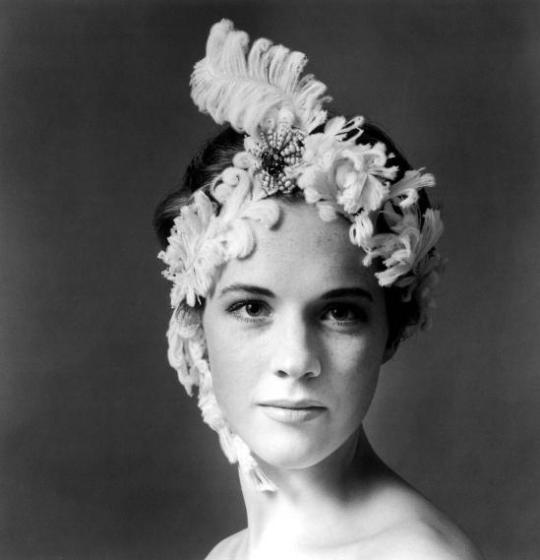

Propaganda
Julie Andrews (The Sound of Music, Mary Poppins)—Oh where to start .... I'm not sure I even know how. She's just perfection. And it's not fair I can't bring post 70s work into this, because she just gets better and better, and her drag performance in to die for. But in the era I CAN talk about, she shows she has THE RANGE. Beautiful, feisty, funny, holding her own against Christopher Plummer, Paul Newman, Rock Hudson. Oh she's luminous.
Nadira (Shree 420, Dil Apna Aur Preet Parai)— She had a blast playing the femme fatal in Indian films in the 50s. Also the costumes she wore in Shree 420 are absolutely iconic. It's important to mention that she was Jewish. She was born Farhad "Florence" Ezekiel in Baghdad to an Iraqi Jewish family. They moved to India sometime in the 1940s. The funny thing is that she originally wanted to convert to Catholicism and become a nun but joined the film industry instead as her family desperately needed money. Even though she was unfortunately typecast in femme fatale roles after playing the nightclub entertainer Maya in Shree 420, she always gave 110% to every role she was cast in. Apparently she acted in a German film as well? She was also one of the most highly paid actresses in the Indian film industry and was one of the few Indians to own a Rolls Royce.
This is round 3 of the tournament. All other polls in this bracket can be found here. Please reblog with further support of your beloved hot sexy vintage woman.
[additional propaganda submitted under the cut.]
Julie Andrews propaganda:
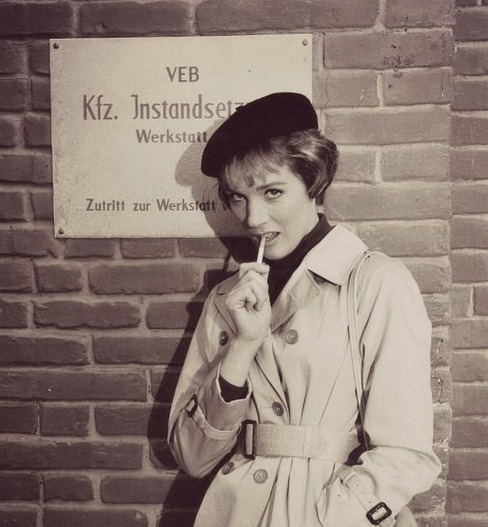
"She has such a simple but amazing beauty to her. Not to mention her amazing and melodic singing voice!"

"Roles like nannies and governesses can make us forget how attractive she was! A perfect combination of elegant and adorable, with the most incredible vocal range to boot!"

"Besides having one of the most amazing singing voices ever to grace the silver screen, Julie always had an understated beauty to her that wasn't always shown off on screen. But it's there nonetheless because her characters managed to pull some of the hottest men ever to grace the screen."

"The juxtaposition between carefree Maria and stern but fun Mary Poppins shows the power of the acting of this HOT VINTAGE MOVIE WOMAN"
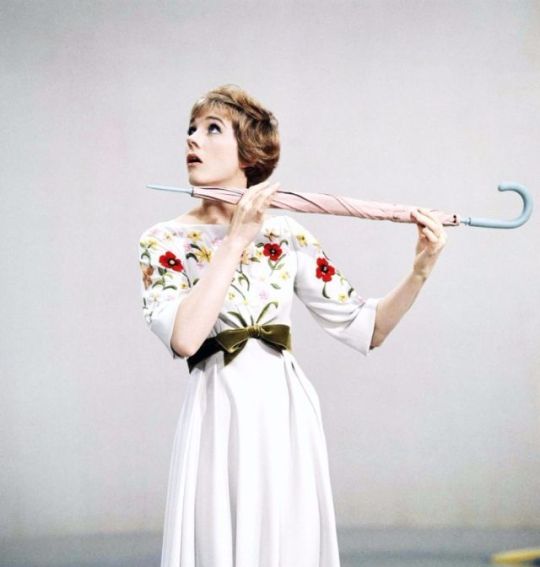
"Charming, genteel, incredibly charismatic, beautiful, and has an angelic singing voice to boot. Her screen roles as Maria in The Sound of Music and Mary Poppins are absolutely iconic for a reason and she originated several well-known Broadway roles before those."
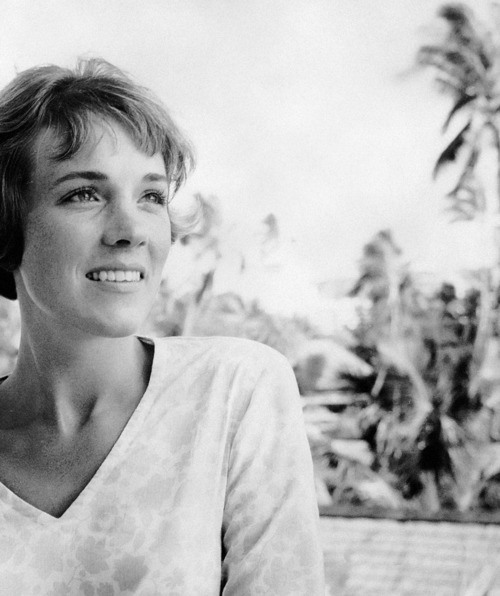
"the most beautiful woman 12 year old me had ever seen possibly"
"OMG OMG OMG she’s definitely been submitted before how could she NOT but!!!! I loveeee her so muchhhh rahhhh prebby!!!! cool!!!! mary poppins the beloved <33333 some people dislike it but I love jolly holiday so much because it IS a jolly holiday with Mary!!! no wonder that it’s Mary that we love!!!!!"
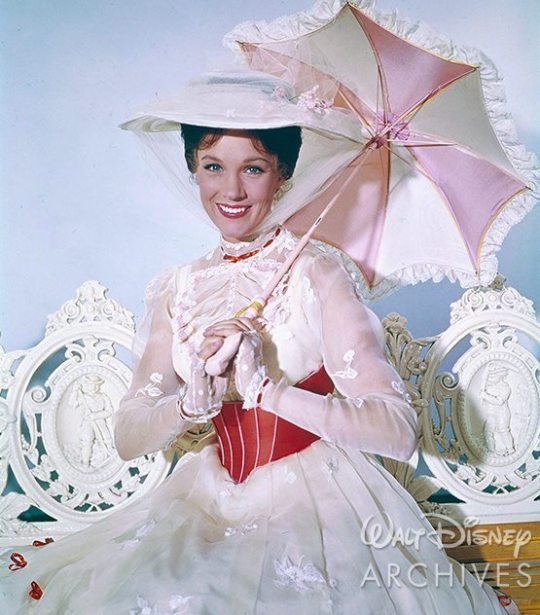
"I know many people who were taught in singing lessons "when in doubt, pronounce words how julie andrews would pronounce them." THATS CALLED INFLUENCE. THATS CALLED MOTHERING THOUSANDS."
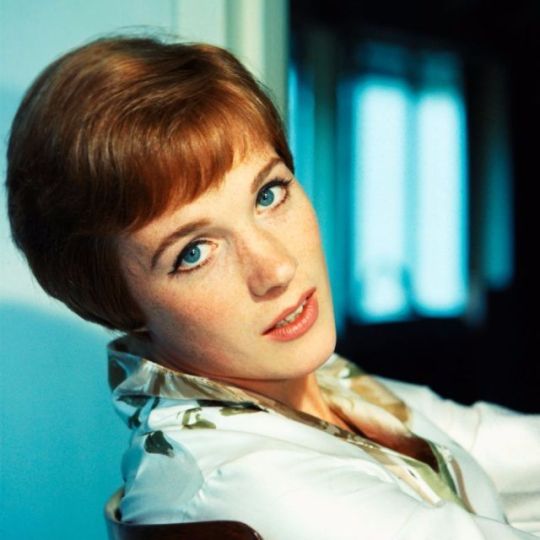
Nadira:
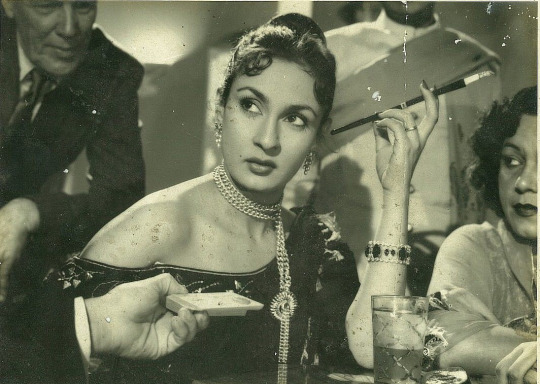
I just submitted a whole list of golden-era Bollywood stars without whom I thought this tournament could not conscionably be considered complete BUT Nadira has got my personal vote for Hottest of the lot. She played a bunch of delicious vamp roles in her youth before graduating to being a creepy spiderlady antagonist type in middle/older age. Rare is the still in which she looks like she's NOT about to gnaw your face off. Yow!

204 notes
·
View notes
Text
EXTERNAL INFLUENCES IN DUNGEON MESHI: INDIAN PHILOSOPHY
(SPOILERS FOR DUNGEON MESHI BELOW)
We know that Ryoko Kui spent considerable time at the beginning of working on Dungeon Meshi doing research and planning the series. Kui constantly references real world culture, history and mythology, but she also occasionally references real-world philosophy.
The story of Dungeon Meshi is full of philosophical questions about the joy and privilege of being alive, the inevitability of death and loss, the importance of taking care of yourself and your loved ones, and the purpose and true nature of desire. Kui explores these issues through the plot, the characters, and even the fundamental building blocks that make up her fictional fantasy world. Though it’s impossible to say without Kui making a statement on the issue, I believe Dungeon Meshi reflects many elements of ancient Indian philosophy and religion.
It’s possible that Kui just finds these ideas interesting to write about, but doesn’t have any personal affiliation with either religion, however I would not be at all surprised if I learned that Kui is a Buddhist, or has personal experience with Buddhism, since it’s one of the major religions in Japan.
I could write many essays trying to explain these extremely complex concepts, and I know that my understanding of them is imperfect, but I’ll do my best to explain them in as simple a way as possible to illustrate how these ideas may have influenced Kui’s work.
HINDUISM

Hinduism is the third-largest religion in the world and originates in India. The term Hinduism is a huge umbrella that encompasses many diverse systems of thought, but they have some shared theological elements, and share many ancient texts and myths.
According to Classical Hindu belief, there are four core goals in human life, and they are the pursuit of dharma, artha, kama, and moksha.
Dharma is the natural order of the universe, and also one’s obligation to carry out their part in it. It is the pursuit and execution of one’s inherent nature and true calling, playing one’s role in the cosmic order.
Artha is the resources needed for an individual’s material well-being. A central premise of Hindu philosophy is that every person should live a joyous, pleasurable and fulfilling life, where every person's needs are acknowledged and fulfilled. A person's needs can only be fulfilled when sufficient means are available.
Kama is sensory, emotional, and aesthetic pleasure. Often misinterpreted to only mean “sexual desire”, kama is any kind of enjoyment derived from one or more of the five senses, including things like having sex, eating, listening to music, or admiring a painting. The pursuit of kama is considered an essential part of healthy human life, as long as it is in balance with the pursuit of the three other goals.
Moksha is peace, release, nirvana, and ultimate enlightenment. Moksha is freedom from ignorance through self-knowledge and true understanding of the universe, and the end of the inevitable suffering caused by the struggle of being alive. When one has reached true enlightenment, has nothing more to learn or understand about the universe, and has let go of all earthly desires, they have attained moksha, and they will not be reborn again. In Hinduism’s ancient texts, moksha is seen as achievable through the same techniques used to practice dharma, for example self-reflection and self-control. Moksha is sometimes described as self-discipline that is so perfect that it becomes unconscious behavior.
The core conflict of Hinduism is the eternal struggle between the material and immaterial world. It is often said that all of the material world is “an illusion,” and what this means is that all good and bad things will inevitably end, because the material world is finite. On the one hand, this is sad, because everything good in life will one day cease to exist, but on the other hand, this is reassuring, because all of the bad things will eventually end as well, and if one can accept this, they will be at peace.
The central debate of Hinduism is, which is more important: Satisfying your needs as a living thing, having a good life as a productive member of society, serving yourself, your family, and the world by participating in it the way nature intended? Or is it rejecting desire and attachment, discovering the true nature of existence, realizing the impermanence of material things, and that one can only escape the suffering that comes from the struggle of life by accepting that death and loss are inevitable?
There is no set answer to this question, and most believers of Hinduism tend to strike a balance between the two extremes simply because that’s what happens when a person leads a normal, average life, however there are also those who believe that pursuing extremes will lead to ultimate enlightenment and final release as well.
BUDDHISM
Buddhism is an Indian religion and philosophical tradition that originated in the 5th century BCE, based on teachings attributed to religious teacher the Buddha. It is the world's fourth-largest religion and though it began in India, it has spread throughout all of Asia and has played a major role in Asian culture and spirituality, eventually spreading to the West beginning in the 20th century.
Buddhism is partially derived from the same worldview and philosophical belief system as Hinduism, and the main difference is that the Buddha taught that there is a “middle way” that all people should strive to attain, and that the excesses of asceticism (total self-denial) or hedonism (total self-indulgence) practiced by some Hindus could not lead a person to moksha/enlightenment/release from suffering.
Buddhism teaches that the primary source of suffering in life is caused by misperception or ignorance of two truths; nothing is permanent, and there is no individual self.
Buddhists believe that dukkha (suffering) is an innate characteristic of life, and it is manifested in trying to “have” or “keep” things, due to fear of loss and suffering. Dukkha is caused by desire. Dukkha can be ended by ceasing to feel desire through achieving enlightenment and understanding that everything is a temporary illusion.
There are many, many other differences between Hinduism and Buddhism, but these elements are the ones that I think are most relevant to Kui’s work.
Extreme hedonism involves seeking sensual pleasure without any limits. This could just be indulging in what people would consider “normal” pleasures, like food, sex, drugs and the arts, but it can also involve doing things which are considered socially repugnant, either literally or by taking part in symbolic rituals that represent these acts. Some examples are holding religious meetings in forbidden places, consuming forbidden substances (including human flesh), using human bones as tools, or engaging in sex with partners who are considered socially unacceptable (unclean, wrong gender, too young, too old, related to the practitioner). Again, these acts may be done literally or symbolically.
Extreme ascetic practices involve anything that torments the physical body, and some examples are meditation without breathing, the total suppression of bodily movement, refusing to lay down, tearing out the hair, going naked, wearing rough and painful clothing, laying on a mat of thorns, or starving oneself.
HOW THIS CONNECTS TO DUNGEON MESHI
Kui’s most emphasized message in Dungeon Meshi is that being alive is a fleeting, temporary experience that once lost, cannot truly be regained, and is therefore precious in its rarity. Kui also tells us that to be alive means to desire things, that one cannot exist without the other, that desire is essential for life. This reflects the four core goals of human life in Hinduism and Buddhism, but also could be a criticism of some aspects of these philosophies.
I think Kui’s story shows the logical functionality of the four core goals: only characters who properly take care of themselves, and who accept the risk of suffering are able to thrive and experience joy. I think Kui agrees with the Buddhist stance that neither extreme hedonism nor extreme self-denial can lead to enlightenment and ultimate bliss… But I also think that Kui may be saying that ultimate bliss is an illusion, and that the greatest bliss can only be found while a person is still alive, experiencing both loss and desire as a living being.
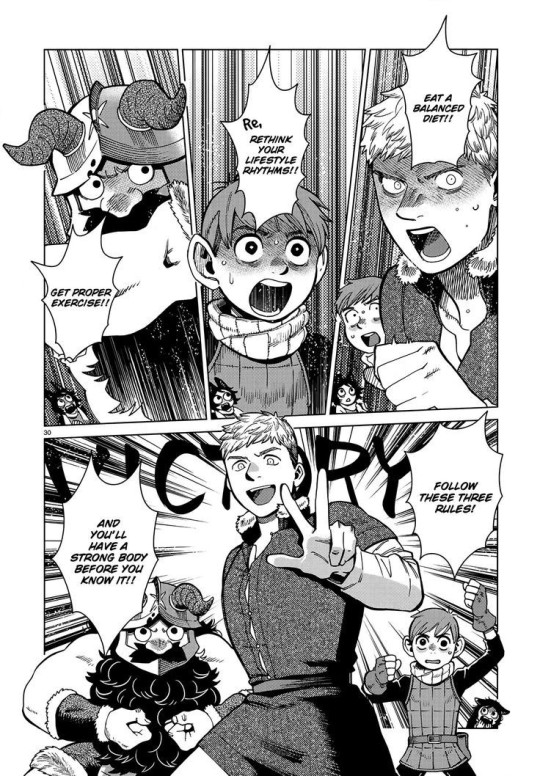
Kui tells us living things should strive to remain alive, no matter how difficult living may be sometimes, because taking part in life is inherently valuable. All joy and happiness comes from being alive and sharing that precious, limited life with the people around you, and knowing that happiness is finite and must be savored.
Dungeon Meshi tells us souls exist, but never tells us where they go or what happens after death. I think this is very intentional, because Kui doesn’t want readers to think that the characters can just give up and be happy in their next life, or in an afterlife.
There is resurrection in Dungeon Meshi, but thematically there are really no true “second chances.” Although in-universe society views revival as an unambiguous good and moral imperative, Kui repeatedly reminds us of its unnatural and dangerous nature. Although reviving Falin is a central goal of the story, it is only when Laios and Marcille are able to let go of her that the revival finally works… And after the manga’s ending, Kui tells us Falin leaves Laios and Marcille behind to travel the world alone, which essentially makes her dead to them anyway, since she is absent from their lives.
At the same time, Kui tells us that trying to prevent death, or avoid all suffering and loss is a foolish quest that will never end in happiness, because loss and suffering are inevitable and must someday be endured as part of the cycle of life. Happiness cannot exist without suffering, just like the joy of eating requires the existence of hunger, and even starvation.
Kui equates eating with desire itself, using it as a metaphor to describe anything a living creature might want, Kui also views the literal act of eating as the deepest, most fundamental desire of a living thing, the desire that all other desires are built on top of. If a living thing doesn’t eat, it will not have the energy necessary to engage with any other part of life. Toshiro, Mithrun, and Kabru are all examples of this in the story: They don’t take care of themselves and they actively avoid eating, and as a result they suffer from weakness, and struggle to realize their other desires.
Kui suggests that the key difference between being alive or dead is whether or not someone experiences desire. If you are alive, even if you feel empty and cannot identify your desires like Mithrun, you still have desires because you would be dead without them. The living body desires to breathe, to eat, to sleep, even if a person has become numb, or rejected those desires either to punish themselves, or out of a lack of self-love.
Sometimes, we have to do things which are painful and unpleasant, in order to enjoy the good things that make us happy. I believe Kui is telling us that giving up, falling into despair, and refusing to participate in life is not a viable solution either.
The demon only learns to experience desire by entering into and existing in the material, finite world. This experience intoxicates the demon, and it becomes addicted to feeling both the suffering of desire, and the satisfaction of having it fulfilled. This unnatural situation is what endangers the Dungeon Meshi world, and it’s only by purging the demon of this ability to desire that the world can be saved. The demon is like a corrupted Buddha that must give up its desires in order to return to the peaceful existence it had before it was corrupted.
The demon curses Laios to never achieve his greatest desires at the end of the manga, which manifests in several ways, such as losing his monstrous form, Falin choosing to leave after she’s revived, and being unable to get close to monsters because they are afraid of him. In some ways you could compare Laios to a Bodhisattva, a person who tries to aid others in finding nirvana/moksha, even if it prolongs their own suffering and prevents them from finding personal release. Laios gives the demon peace, but Laios himself will never be able to satisfy his desires, and must eventually come to accept his loss and move on with his life.
(This is an excerpt from Chapter 3 of my Real World Cultural and Linguistic influences in Dungeon Meshi essay.)
#dungeon meshi#delicious in dungeon#the winged lion#dungeon meshi spoilers#laios touden#mithrun of the house of kerensil#analysis#The Essay#After all the conversation about Mithrun I felt it was really important to drop this excerpt today
135 notes
·
View notes
Text
I stretch anywhere a total of 45 minutes to 2.5 hours throughout the day, averaging closer to 2 hours each day. I stretch while chopping for dinner. I stretch after meditation. I stretch before leaving the house and after coming back home from riding my bike. I stretch while folding clothes low to the ground. I stretch at night to good music. I didn’t start actively stretching this way until 3 years ago and if I knew in my 20s and 30s what I know now, I would have started then. Stretching is the most important part of my practice, right behind nature/warm sun. Stretching helps the body release old narratives and receive new more updated ones. We reprogram our minds when we bring more lubrication to our bodies through releasing or softening the contractions in our tissues, ligaments, and joints. Because the perceptions, beliefs, expectations, conditionings and programmings locked into our folds greatly influence the quality of our reality.
The female body is mainly absorptive and receptive—meaning it takes in, sucks in, and receives all manners of information physically, spiritually, and energetically from morning to night. The noisier our bodies are, generally the more contracted and tighter we tend to be, often living in unconscious fight or flight states in our we breathe or move, even though there is no threat in sight. But stretching often throughout the day helps to relax calm the body down from its unconscious holding patterns and release the shadowy accumulations we pick up by nature of being female and having a womb, even the accumulations from other timelines. If your womb has been removed, your body still receives energetically/spiritually. That’s because stretching is not just physical, it’s exceptional spiritual hygiene. Too many accumulations makes our bodies dense and loud. The aim is the soften and quiet down the noise living inside. When your body becomes less noisy, you may notice that you give better eye contact and have more of a relaxed presence in the world. If you are genetically very flexible, you have to discover other ways shadows show up in your body and life.
Most people live disconnected from what is living in their bodies and offshoot the consequences of their lives onto someone or something else. You must know that no one is coming to save you and consciously use your mind, breath, and body to deliberately create from in your current reality. Even 5-10 minutes of stretching morning and night to chanting tones, harp sounds, or affirmation music makes a vast difference overtime. —India Ame‘ye
270 notes
·
View notes
Text
I’ve been stricken with numerous personal life circumstances that have made it difficult to produce solid research pieces as well as answer questions, but I still want to share information.
This type of dance is called Dunhuang and mixes traditional ethnic dancing styles with modern art. The style of the dance itself is influenced heavily by Buddhism. Specific body movements are inspired by fresco paintings found inside the caves of the west China province of Gansu. The dance style owes it’s name to the musical scores found within the city of Dunhuang.
Dunhuang itself used to be a massive center for Buddhist teaching and practices between 500AD-1000AD, being home to several monasteries during that time period. Pilgrims from China, India and Tibet would congregate here leaving behind massive amounts of Buddhist written text and art that would form the strongest body of primary works regarding Buddhist communities in China.
This group here is performing The Thousand Handed Guanyin, and actually happen to be hearing impaired! It’s actually quite mesmerizing to watch.
211 notes
·
View notes
Text
Understanding Lennon McCartney Rewatch Part 2.4
It's in the paper that Allen Klein was involved in 40+ lawsuits and John doesn't question it? At this point, I feel like he just didn't want to let Paul be right about anything.
My question is who did that work on before? I mean who fucking does business like that? Let alone business with the most successful man in the world.

John's complaining about Paul being too good at his job is both hilarious (what the hell is Paul supposed to do with that) and sad (it shows just how far their musical relationship has degraded from partners to rivals)
How did they lose Northern Songs? Genuinely, if anyone can break it down for me I'd be so grateful. Anyway I'm sure it was devastating for both of them. “Who'd have the children?” “Dick James”.
I know I'm insane, but can I be allowed to see a glimmer of goodness here? I really do think it's John's kinder side winning out when he decides not to lie. Like, yes, he gets a buzz off of watching Paul go white at his words, but I think he also just – in that moment – didn't have the heart to trick Paul into staying.

But also. Why are we trying to maneuver Paul at all if the end game is for John to leave? It just doesn't make sense to try to trick Paul into signing the contract unless John's divorce threat is at the very least not meant to be final.
I will never understand this picture. Even in the emotional state he's in, he's still hamming it up? There is something seriously wrong with this man.

I do find it interesting that the fact that Paul cried his eyes out after that meeting isn't even mentioned in the doc. I wonder why.
Let's put the bizarre, super-warped timeline in this quote aside for a minute. Apparently the depression started after Brian died and it lasted for about two years and John was still in it during Pepper. Okay. That aside . . .


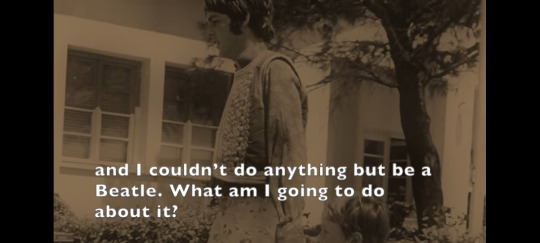
I have to assume this negative lense on what I can only assume means the period between 66 and 68 is highly influenced by hindsight bias. I agree that John was depressed at the time, in an unhappy marriage, doing too much LSD, etc and that looking at Paul's prolific talent and expansive , fast-paced life would have been maddening. But everyone go back to the end of part one really quick. He looks extremely happy. He sounds extremely happy. Everyone who knows him says he's never been happier. I think he just can't accept right now that there was so much good and he's lost it.
“I look from the wings at the play you are staging . . . I don't know why nobody told you how to unfold your love.”
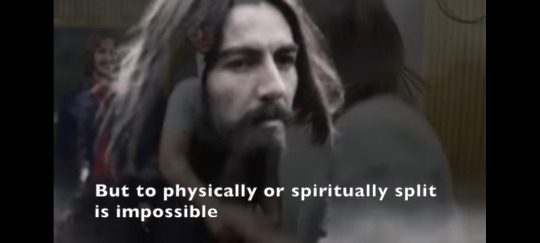
Insanity quote Hall of Fame. Paul explaining why the Beatles just had to break up, obviously, because he and John "didn't marry the same girl." Someone write the fic where John and Paul both marry the same girl. Could be Yoko or Linda. Sister trad wives au.
Okay, cool, so this means I have full permission to interpret and tin hat about any lyrics I want then, right?

But also. Are we just not going to talk about the fact that Paul dumped a bucket of garbage water and punched this person? And are we not mentioning the depression and alcoholism and heroin abuse during this time?
It's so embarrassing how he looks to her for confirmation here. John, they asked you what you think. Just you. Not some complicated definition. Not Yoko's definition. Just your own thoughts.
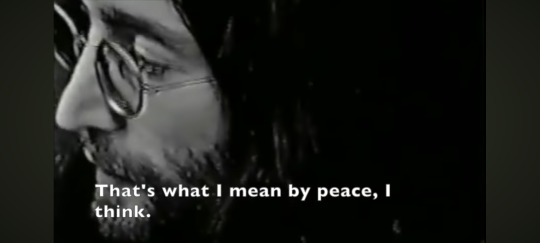
“I couldn't wait for them to make up their mind about peace or whatever. About committing themselves.” Yeah, John. You sound real committed to peace. Or whatever. Here's a theory that anyone can shoot down if they want: John asked Paul for some kind of commitment (a friendship wedding, a partnership contract, a mutual wanking pledge) in India and Paul was a chicken about it.
What was that day like, I wonder? I imagine extremely stiff and professional and horrid. But who knows. Maybe it was nice, and maybe that made everything worse.

I will go to my death believing that instant karma was for Paul.
Do we think John actually did send Paul “about twenty postcards from Denmark” all covered in hearts none of which Paul responded to? Paul could be just as cruel in his lack of reaction as John was in his over reaction.
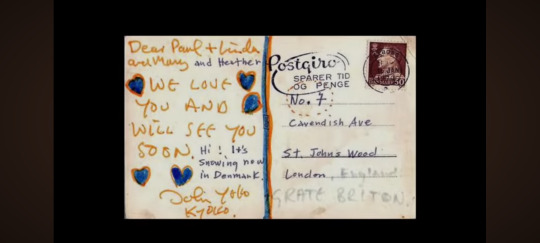
I'm sorry but that is not what a man says when he's just lying to the press to buy time for business. That's what a man says to the press when he's trying desperately to communicate with someone who he can't get through to any other way.



But really, I just don't understand why the creator chose to minimize Paul's emotional response to John's divorce statement. If we don't see him bawling his eyes out and losing the will to live, he comes off like a self-assured, uncaring, jerk. Which. To be fair. John didn't see those things, and that is exactly what John thought of Paul during this time. But still. The audience now comes away from this doc with a skewed view.
All we get is Paul being pissed off about Phil Spector butchering Let it Be without his consent and John and George trying to change McCartney's release date without his consent. Which are both a) understandable and b) strong, male, angry reactions. Making this section portray Paul in the same one-dimensional hyper-masculine way that John so often is. Which isn't my favorite. But hey, it's my only complaint about this doc so far.

Anyway, update: I won't be able to do part three until it gets reuploaded, so we're on hiatus for this project for the time being.
#paul mccartney#the beatles#john lennon#mclennon#ringo starr#george harrison#understanding lennon mccartney#ulm
134 notes
·
View notes
Text
Top 4 Music Influencers Shopping 2024
Music, the universal language of emotions, holds the power to heal and inspire. In today’s digital age, music influencers are at the forefront, showcasing their unique styles and connecting with audiences worldwide. From singers to composers, these influencers navigate diverse genres, captivating listeners and setting trends in the ever-evolving music scene. Here’s a handpicked selection of the top 4 music influencers who are making waves and setting the stage for 2024.

Starting his musical training in Hindustani Classical music during his early childhood, Sumonto has crafted his musical journey from being selected for Saregamapa Lil Champs to becoming a music influencer with his viral music covers. He has become a household name in the music industry, boasting more than 450k followers on Instagram and over 270k views on ‘Khair Mangda’, showcasing his ability to captivate audiences and make them groove to his beat.

Sourav Ray is popularly known for creating mashups, and one of his recent trending mashups is ‘Husn X Let her go’ with millions of views. He is known for producing Lofi mashups to originals. His deep understanding of music and passion to create it in such a way that it touches every soul and resonates with every listener. His talent, hard work, and dedication have paved the way for him to achieve his dreams and goals in life.

Mihika Sansare is popularly known for creating music covers in her unique style and posting them across social media platforms to entertain and engage with her audience. She is a guitarist and a singer with 250k+ followers on Instagram and 600k+ subscribers on YouTube. One of her covers — ‘Tumhe jo maine dekha’ has garnered more than one million views.
Vasu Kainth
Vasu Kainth is a singer, composer, and a songwriter. He has a huge fanbase with 90k+ followers on Instagram and 200k+ subscribers on YouTube. From original songs to mashup videos, he is creating music in a unique way to connect with his audience. He even got the opportunity to collaborate with other renowned musicians from the industry, that feels like a dream come true. From classical roots to innovative mashups and soulful covers, every artist has carved their unique style, resonating with audiences globally. Music influencers have turned social media platforms into their new stage, where they can entertain and connect with their audience.
#Influencer Marketing Agency#Influencer Marketing Agency in India#Music Influencer#Music Influencer in India
0 notes
Text
Monkey Man and why I loved the heck out of it

At it's core, it's a Bollywood flick presented to the West with familiar nods to previous action films - I definitely picked up hints of Tony Jaa's influence on Asian action flicks throughout.
It's heavily focused on police corruption, something commented a lot about in India, and here, more importantly, Indian films. Just like America has its love affair with mobster flicks, Bollywood has a long history featuring films that showcase police corruption, sometimes tied into political extremism, fanatical or greedy religious leaders, and Monkey Man comments on all this as well and pays nods to that commonality. We've got televangelists and religious leaders in the states funnelling money, preaching prosperity gospel, and using it to influence politics and fund lavish lifestyles here.
Monkey Man shows this happening in India, and is filled with Indian culture and symbolism through out. The focus on Hanuman, the god and one worshiped by the strong, chaste, wrestlers, champions, and fighters. It's a common thing to have a household deity if you will. Some families might choose to focus worship on Ganesh, others Hanuman, some might do Mata Rani or Lakshmi. Here, it's the divine Vanara (monkey people race) - one of the Chiranjivi - immortals/forever-lived.
Hanuman. Themes of rebirth, common in South Asian history and mythology are present from Kid being a ringer, beat up fighter getting whooped for money to being reborn and facing his trauma through a ritual/meditate process that I don't want to get too much into to not spoil the movie. Post that, he begins his own self alchemy to really become the true Monkey Man. Nods to Ramayama, and an unapologetically Indian story featuring dialogues throughout in Hindi - don't worry, there are subtitles.
And of course a love for action flicks before it, all the way back to Bruce Lee. A beautiful use tbh of an autorickshaw (and you might know them as tuk-tuks in Thailand) which are popular in India with an added kick...I swear, that thing had to be modified with a hayabusa motor. Which is an actual thing people do - modding those dinky rickshaws with motorcycle engines, and considering they weigh nothing at all, they can REALLY FLY once you do that.
Monkey Man brings to the big screen other elements of India people might not know about, such as the gender non conforming and trans community that has a long history in India, presenting them as action stars as they go up against a system of corrupt elites oppressing part of the city, marginalized communities, and minority voices as depicted in the film. I'm not sure if people are going to get all of that without having the context, but I love that it does it without holding anyone's hands.
It's a fun action flick to see in the age of superhero films, and I say that as an obvious superhero/sff nerd. Also loved that Dev included a little bit about Hanuman's own story in the film, and the loss of his powers - almost mirrored by Kid's own loss of self/skills, strength until he confronts his trauma and is reborn, and in fact, remade (not necessarily the same). Also, the use of music was brilliant, including one scene with a tabla (the paired hand drums of south asia) - and Indian music is central to Indian stories.
This is a culture with evidence going back to the Paleolithic with cave murals showing art of Indian dance nearly 30,000 years ago. Yeah, that far back. As well as Mesolithic period art depicting musical instruments such as gongs, lyres, and more.
Indian music is some of the earliest we can find that has high developed beat and rhythm structures such as 5, 7, 9 and now the extremely common and known 4/4 and 3/4 - which so much of Western music is built upon. The foundations and experimentation of/in Jazz. John Coltrane and John Cage were heavily inspired by Indian music and incorporated a lot from it into their works. And Monkey Man blends Eastern and Western music through the narrative as comfortably as it does an Indian story in a very familiar Western accessible structure.
Dev did a wonderful job. And thanks to Jordan Peele for bringing it to screens.
#monkey man#jordan peele#dev patel#Bollywood#bollywood movies#Indian films#indian culture#India#hanuman#ganesh#south asian#Ramayama#superhero#superhero films#Indian music#bollywood songs#loved this film#great film#love this movie#john coltrane#John Cage#Jazz#music soundtrack#films#movies#movie review
55 notes
·
View notes
Text
Frye is the new Marina: Exploring Frye and Minority Anxiety (An essay by @Terminatorbuns)
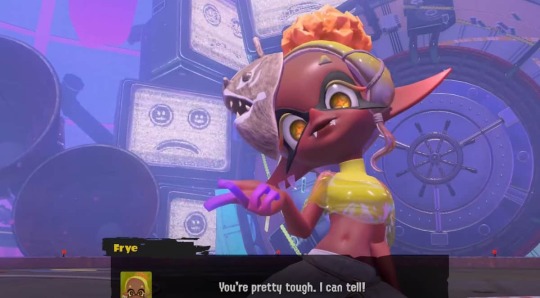
I'm gonna preface this with something very important: Frye is best girl. Fight me, I write lore essays. I wrote that other essay on Deep Cut and I've continued to obsess over them since, especially on Frye, who's been an extremely interesting character for me to analyze.
We know Frye, she's the chipper Inkling idol partner to the more sophisticated Octoling Shiver. There's obvious parallels to be made with the previous idol group, Off the Hook, since Frye is like the energetic Pearl and Shiver is like the cool Marina. And uhh .. that's probably all there is to it, essay's over, everyone go home.
No but seriously, what I want to share instead today is the personal, alternative interpretation I arrived at after obsessively overthinking the situation since release. It's not fully supported by canon, but this is a reading of Frye constructed from the most subtle lore details a Frye-obsessed lore nerd could find, and I hope to at least highlight some lore elements the community might have missed. I want to demonstrate the layers upon layers of complexity that can be read into Frye as a character, and why I care so fucking much.
Frye isn't the new Pearl, she was the new MARINA this whole time and it took me months to see it. Yes, it has absolutely everything to do with their skin color. Splatoon's world is designed with real life racial diversity in mind and, intentionally or not, are also influenced by real life racial dynamics in turn. Like Marina, the analysis of Frye absolutely OPENS UP if we examine her through the lens of her real life racial status, we start to infer stuff about her motivations, her fears, her secret needs and wants, EVERYTHING is on the table. Good news for Shiver fans, I can't talk about Frye without digging into her relationship with Shiver (platonic or otherwise) so that's going to happen too. We need to talk about our precious brown baby.
1. Frye the Minority
To state the obvious, Frye's ethnicity is South Asian, probably India. The Splatoon world doesn't really have a Squid India in it but it's clear what her real life inspirations are. She's very brown, she wears Aladdin pants and mango chutney on her head. She's got a snake charmer flute thing going on and all her musical motifs are played with South Asian instruments. It's a bit on the nose.
Thing is, Splatsville is a Japanese city in design. Splatsville is called Bankara city in Japanese, it's named after a literal Japanese fashion movement and the visual design elements of Splatsville are reminiscent of a rural Japanese city. Splatsville takes little visual inspiration from South Asia, and that makes sense since Splatoon is made by Japanese devs who would be most familiar with Japan.
The consequence of this is that Frye stands out as a uniquely brown-coded person in a world where nobody else looks like her. Not even playable inklings with dark skin look like her, what with her teeth and her pointy mask and her big forehead. It's worth noting that the Octoling narrative in Splatoon 2 takes inspiration from the experience of Black Americans, and the dark skinned Octolings of Inkopolis are mostly coded black, not South Asian. Even if the racial identities of squids don't necessarily match real world racial identities, Frye is recognizably a minority both visually and culturally in-universe. This is reminiscent of Marina, who was one of the only visible Octolings in Inkopolis until playable Octolings were formally implemented.
It's worth noting now that Shiver, in contrast, fits in perfectly: she's a traditionally attractive Japanese girl (we're talking about fem Shiver right now, bear with me) in a Japanese city. Even though Octolings should be an in-universe minority, and even though she too has somewhat unconventional features, the idea that she's a minority just doesn't track visually. We'll circle back to this and discuss why it doesn't really work for her character narratively either.
2. Frye the Villain
I've covered this in my previous essay but Frye is a stage villain by trade, and her style of performance is inspired by Kabuki. The Japanese inspiration makes sense, even though she's an ethnic minority her sunken scrolls suggests that her family is well established in the region, meaning they immigrated a long time ago and Frye's grown up in Splatsville. Frye is a Japanese national with roots in South Asian culture, it's understandable that she has adopted mannerisms of both cultures.
But like, why a villain? And what's the deal with Marina also representing Team Villain in the heroes vs villains Splatfest? I was wondering if there was a connection there until it hit me, Frye's TOO BROWN to apply for hero roles. In real life, the Japanese entertainment industry famously has problems with colorism and racial representation. Even darker skinned Japanese people have trouble landing gigs as leading heroes because the industry favors light skin, and Frye is both very brown and not conventionally attractive by Japanese standards. Film industries in the West have very similar problems with colorism so it's a recognizable problem to western audiences, also. Frye's career choice as a professional villain is informed by the fact that people like her literally cannot land jobs as heroes.
That's not to say Frye resents her role, Frye loves being a villain. Her poses are dynamic, her speeches are charismatic, she's at her happiest when she is playing an antagonist. If you look at her blasting off with her smoke bomb, she has the happiest smile on in direct contrast to Shiver who's comically losing her shit. Thing is, Frye identifies with the underdog villains who never win, because Frye herself struggles in an industry that does not favor her. This also explains her sympathies for the underprivileged, and why she's made it a personal mission to raise money for the poor. Looking back at Splatoon 2, Marina was sympathetic to villains for the same reasons, as an Octoling (and as a black person) that was villainized by the society she lives in.
Frye brings her cultural identity into her performance, where she incorporates traditional South Asian dance and snake/eel charming into her fighting style. She takes her heritage seriously too: where Frye comes off as a clown elsewhere, she's deadly serious when using her culturally inspired techniques in a fight. The fact that she has named choreography for each phase of her fight is proof enough of that. Deep Cut's boss fight theme also opens with South Asian instruments and they are the most prominent thematic element throughout, highlighting the fact that villainy is Frye's domain of expertise, not Shiver's. Frye sees both villainy and her cultural background as core parts of her identity and expresses herself with a combination of both.
3. Frye the loner
Thinking back to Splatoon 2, Marina and Pearl had a very clear extrovert vs Introvert dynamic: Pearl likes networking and building musical connections, and Marina is shy and prefers to hole up in a comfy chair and write music all day. We do in fact see this again in Deep Cut, except Shiver is the extrovert who flourishes in front of an audience or a camera. She's eager to play tableturf with agent 3 because she just likes social interaction and competition. The Anarchy Splatcast version of the Deep Cut theme instead features Japanese instruments, signaling that newscasting in front of a camera is Shiver's area of expertise. Shiver's design and mannerisms also visually invoke that of a Geisha, who are professional entertainers trained in hospitality.
You see where I'm going with this, I hope. In a wild fucking twist, the cheerful energetic Frye is secretly an INTROVERT. Frye's area of expertise is the desert wastelands, she's at her most comfortable when there's almost nobody around. She's happy to be on camera with her friends but she also squirms in her seat, being not completely comfortable. Her go-to stress reliever is fighting salmonids who do not speak, and Shiver tells us that Frye runs away from the group during a Salmon Run shift to fight the bosses. Also, Frye's villain specialty isn't well suited to making friends when she kinda attacks strangers on sight.
Frye's tableturf habits are most revealing because she does not make eye contact with Agent 3 sitting across a table from 3. Frye's zoned out thinking about Big Man and Shiver, her closest friends and the people she's most comfortable around. In the news room Frye's attention is also focused on her friends and rarely makes eye contact with the camera. Without her friends nearby, Frye can actually get a bit lost in a social setting.
This reminds us of Marina who's also shy around people, except Marina's anxieties come from being a literal enemy of the state. Marina actually has quite a few contacts in the Octoling community despite being nervous around Inklings for good reasons. Frye has habits that ACTIVELY avoid people, and currently we're not sure she has ANY friends outside of Deep Cut. There's likely a racial aspect to this, of course, the same cultural biases that prevent Frye from playing hero roles are also likely affecting her ability to connect with new people, and it's not a big stretch to guess how it affects her personal habits. Frye doesn't have Shiver's conventionally good looks, she makes a poor first impression as a pointy big headed brown girl in a Japanese-coded world. This might feel a bit familiar as we've seen a similar process play out in real life since Shiver was a lot more well received at launch and Frye took more time to grow on the fandom.
4. Marina and minority excellence
So we've established some similarities between Frye and Marina in that they are likely both introverts affected by racial anxieties, but it's also worth discussing the ways in which they differ. I feel that Frye and Marina take two different approaches to address their racial anxieties, and this accounts for their very different personalities as characters.
Marina represents a picture perfect image of black excellence on an Octopus. She's a prodigy composer that knows every fucking black music style and a genius engineer and she can even draw manga; girl works three jobs. Marina's approach to her minority status is to work hard to be an exceptional representative of her people in the hopes that it will help them be accepted in Inkling society. She's determined to be presentable to the degree that she will hide some parts of her past (although those parts involved a lot of weapons engineering so maybe it's for the best that she's not proud of that). Also, and this is a very lukewarm take, Marina is hot.
Frye has to take a different approach out of necessity, because Frye is not a genius. As talented as she is, Frye is a more average person with anxieties and flaws that she can't hide, and she doesn't have the talent to excel in multiple fields of expertise or the patience to learn how to present herself in polite society. Rather, Frye channels her flaws into her art: her violent tendencies and her social anxieties both inform her villain performance, giving her a distinct edge and charisma that suits her chosen art form. In Japanese, Frye also speaks with distinct country bumpkin mannerisms which are also associated with low societal status. Thing is, Frye embodies Splatoon 3's theme of Chaos as a non-conformist: she can't succeed by conforming to polite societal standards, so she chooses to promote her own, rough around the edges style as a viable art form.
I'm fascinated with this particular interpretation of Frye, whether or not it was intentional by the original designers at Nintendo, because of how much depth it gives Frye's personality. Not only that, but this version of Frye also creates some interesting implications for her contrasting partner, Shiver.
5. Making sense of Shiver
Shiver's role in Splatoon 3 is rather mysterious when you think about it. Our previous understanding was that Octolings was an oppressed racial underclass that come from the military dictatorship in Octo Canyon and have only been integrated into Inkling society for 2-4 years. And yet, Shiver's family history goes back pretty far with very specific artistic traditions that they've preserved, and she has distinctly different visual features than the Octolings of Octo Canyon. I should also point out that the systematic oppression of Octolings draws heavy parallels to the experiences of Black people in America and Japan, and Shiver is… very not black.
Shiver doesn't really work as an Octoling from Octo Canyon, but she also doesn't have to. The Splatlands is a new region with new history and racial politics, Shiver starts making more sense if we assume that she's been in Splatsville this whole time, and her family simply wasn't living under DJ Octavio's rule. If Shiver's history isn't tied to the Octo Canyon narrative, then we have some very interesting angles to explore through the lens of her IRL racial identity as a Japanese girl and how that effects her design and personality. If we follow this line of logic to its conclusion, we'll start to understand how Shiver is actually the new Pearl.
Shiver as a character design is defined by privilege, or at least, the ILLUSION of privilege (more on this later). She's conventionally attractive by Japanese standards in a Japanese setting, so she has the natural advantages of being a member of the racial majority where Frye does not. Shiver's Japanese dialogue speaks in a very formal theatrical tongue which is… fucking weird admittedly but also a clear allusion to high social status, in the same way people use Shakespearen English to sound fancy as shit. Shiver has the looks and mannerisms of a highly presentable racial default Japanese entertainer and she takes advantage of that to achieve her personal goals.
Shiver's goal is to be on TV. Shiver is Deep Cut's newsroom specialist, she wants to be on camera and to be seen by everyone, she's a little obsessive about attention really. Shiver knows her looks are naturally appealing and wants to be in a format where people can see her face, and she uses stage makeup to accentuate her strengths. This is in direct contrast to Frye who prefers stage performance for smaller, curated audience's, and even then Frye uses a mask to hide her face in battle.
This is where Shiver's relationship with Frye starts to resemble Pearl and Marina. Shiver is perfectly aware of her natural advantages as a fair skinned person and has extended that privilege to include her dark skinned partner. This is similar to the same that light skinned Pearl makes it a mission to promote Marina as a minority artist (Pearl's privilege in this case being mountains of money rather than attractiveness). Even though TV is not Frye's specialty, Shiver insists that Frye (and Big Man) be included because Shiver thinks they deserve a spotlight.
That being said, Shiver's style of partnership differs greatly from Pearl. Pearl has a partner with confidence problems, so Pearl takes a very hands on approach to push Marina to seek out new artistic styles and opportunities because Marina is directionless without guidance. Pearl has high expectations for Marina because Marina is a prodigy who will rise to meet those expectations, and Marina appreciates Pearl's involvement greatly. Marina in turn helps Pearl with her destructive vocals, they fill in each other's weaknesses while working towards a similar goal.
In contrast Shiver takes a hands off approach to Frye. Both Shiver and Frye are confident entertainers in different fields of expertise and do not need external motivation, so they do not need to push each other in the same way Pearl and Marina do. What they instead do for each other is provide safe spaces to participate in each other's art forms without judgment: Frye comes to the TV studio despite being awkward on camera, and Shiver gets to play a villain despite being clumsy and manic on stage. Big Man gets to show up to both despite having little ability in either field.
6. Shiver x Frye
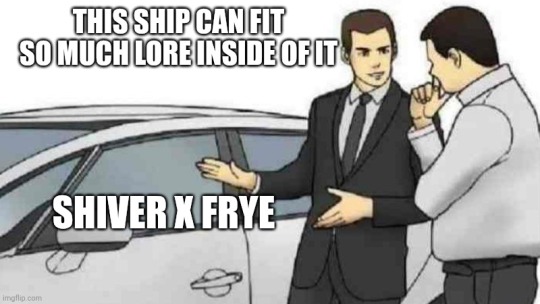
I'm not saying Shiver and Frye have to be a romantic couple, they form an excellent platonic duo dynamic that is just as narratively valuable to the world of Splatoon. I would never be so crass as to suggest that Shiver and Frye should kiss passionately on the mouth. But like, with the information we now have we can dive a little deeper and make some educated guesses on the inner workings of this particular pairing.
Shiver and Frye directly influence each other's personalities, each member of the duo changes when the other is around. Frye becomes softer around Shiver: Frye on her own is tough from a life informed by adversity, she's focused and takes losses with dignity. However, Shiver is using her personal privileges as a light skinned, presentable Japanese girl as a shield for Frye's racial disadvantages to get Frye TV opportunities that Frye would not have had access to alone, and I think Frye appreciates the protection. Frye feels safe enough around Shiver to let her guard down, she feels less pressure to be strong and competent and has an opportunity to be goofier and more vulnerable. This is the Frye we see most often on screen.
Shiver becomes edgier around Frye: Shiver gets to play a villain when treasure hunting with Frye, And we discover that her villain performance is BUCK WILD. This is the second layer of Shiver's personality that I've only alluded to so far, but it's very important to discuss what Shiver gets out of her relationship with Frye.
Shiver's character is about presentation; she has gone to great lengths to learn the behaviors of a traditionally feminine, high class entertainer. She's polite to a fault and extremely particular about her movements both on TV and on a dance stage. There's no reason to believe this is a facade, Shiver has put so much energy into her act that it's more likely that this is Shiver's idealized self, the image she actually wants to present to the world.
What is simultaneously true is that Shiver DOESN'T perfectly conform to her own idealized self image. There's a messier side to Shiver's personality that she tries very hard to hide: she's competitive, petty, and vindictive under specific circumstances, all traditionally unfeminine traits. She's not doing a great job at hiding them either, these traits are part of her personality and slip out despite her best efforts. It's important to consider that Shiver likely also grew up in Splatsville, making her a country girl too with the same rough rural upbringing as Frye. This just makes her attempt to present as high-class even funnier.
My personal interpretation of the dynamic of Frye's relationship to Shiver is that Frye accepts all of Shiver's messier personality traits, enjoys them, even. Frye is a deliquent that stands for conflict and non-conformity to begin with, so Frye offers a safe space where Shiver can both embrace her messier side and be celebrated for it. Shiver can take nasty verbal jabs at Frye and Frye will fire back cheerfully. This is why Shiver is so wild as a villain, the repressed parts of her personality comes out in full display when she's in a space with only Frye and Big Man, and Frye in particular seems to know all of Shiver's secrets to a level that Big Man does not. This way, Shiver feels no need to erase the messier parts of her personality, she simply saves it for the people she trusts. And Frye is the person Shiver trusts the most.
7. Shiver's Gender
I saved this for last because we have little evidential support for it in canon, but the Shiver character analysis really isn't complete without it. Up to this point I have referred to Shiver with She/Her pronouns because that is Nintendo NA's current official stance on the matter (I'm going to keep doing it for consistency but I really don't feel strongly about this), and my analysis is written with the assumption that Shiver is a cisgendered woman. BUT. I actually see no reason that an alternative interpretation cannot be true.
The overall art community has already figured out that there's a VERY potent TRANS narrative that can be told with Shiver. Shiver's narrative is about presenting as a traditional cisgendered girl while struggling with all the ways she does not conform to tradition, but there's an entirely new layer of meaning to this if Shiver is not, in fact, cisgendered in some way. There's a lot of visual information that initially led the community to this interpretation, Shiver's features are more androgynous than feminine, she wears a Sarashi wrap that has cultural connotations of being a binder, and she has a half shaved punk hair cut which is traditionally considered to be very unfeminine. Shiver's art form itself is gendered, as she has the design elements of a Geisha which is a feminine job, but the gender she presents on the job doesn't have to match her personal gender identity: drag queens exist, for example. I'd also like to point out that historically, there were in fact, MALE geishas that went by the title of Taikomochi, they are just less common in modern days.
In practice, Shiver's gender expression is so complicated that ANY interpretation is viable. Not only that but the various trans interpretations have VERY interesting implications. This would recontextualize Shiver's advantages not as majority privilege, but PASSING privilege, or the ability to LOOK heteronormative while not actually being that. It adds a lot of meaning to Shiver's focus on presentation, and her desire to be validated by a lot of people on TV.
Additionally, this would reinforce the idea that Shiver needs an outlet to address her gender nonconformity off screen, and trusted, accepting friends to keep her secrets while she perfects her preferred forms of gender expression. It's the exact sort of thing that would draw her to the delinquent Frye who has no respect for tradition, and who would encourage Shiver to embrace the most literal interpretation of "be gay, do crimes". It would connect Frye and Shiver as two parallel interpretations of minority anxiety in the same game: one who passes for "normal" and one who does not, and how differently they see the world. And that's… kinda beautiful?
At this point I don't have the relevant personal experience to dive any deeper into possible trans interpretations of Shiver, I think there are other artists with more relevant backgrounds that are already exploring this topic. Just know that I've seen the art that depicts Shiver with top surgery scars and they are my favorite.
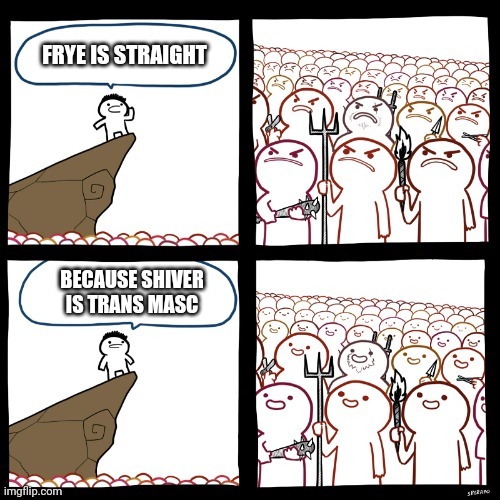
8. Conclusion
Deep Cut's only been out three months and I've already written this much about their lore, good lord. I'm an artist who works on Splatoon fan fiction so the story and themes of Splatoon matter a lot to me as they influence the direction of my work, but my god, does Deep Cut give me a lot to work with. Some of this will have to be retracted as we learn more about Deep Cut's lore, there's lots of ways Nintendo can introduce canon to contradict my take, and that's fine GIVE US THE LORE. Regardless I plan to be making more Deep Cut fan content in the future and I really wanted to share the information that my future work will be based on.
998 notes
·
View notes
Text
i was just about to watch this video by Cheyenne Lin
youtube
Avatar and the Wh*te Imagination (or lack thereof)
about the limits of white imagination and how evident it is in the Avatar movies, and it just reminded me that james cameron worked with an ethnomusicologist, Dr Wanda Bryant, to make music for the na'vi because he wanted something that "would sound like nothing we’ve ever heard on earth" then he decided what was made was too otherworldly and decided that their music should just be what white people would call "alien" and ethnic, aka, whatever music exists in African, Asian and Native American cultures (and that was the final result).
Originally there were many influences coming from all over the globe, but when Cameron listened to the demos, he claimed it was too recognisable as well as too 'weird', albeit for white people and just pushed for a more 'down to earth' version. Avatar is evidence of the continuation of generalized exoticism and stereotyping still being a driving force in Hollywood

[IMAGE ID: A screenshot of a segment from the journal entry written by ethnomusicologist, Dr Bryant discussing the process of creating the music for the avatar films that reads:
"In our initial phone conversation, Horner asked me to find unusual musical sounds that “no one has heard before,” by which he really meant sounds not readily recognizable by the average American movie-goer as belonging to a specific culture, time period, or geographical location"
/END ID]
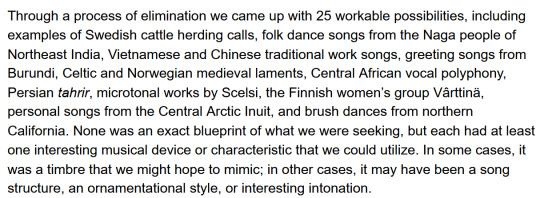
[IMAGE ID: A screenshot of a paragraph from the journal entry written by ethnomusicologist, Dr Bryant discussing the process of creating the music for the avatar films that reads:
"Through a process of elimination we came up with 25 workable possibilities, including examples of Swedish cattle herding calls, folk dance songs from the Naga people of Northeast India, Vietnamese and Chinese traditional work songs, greeting songs from Burundi, Celtic and Norwegian medieval laments, Central African vocal polyphony, Persian tahrir, microtonal works by Scelsi, the Finnish women’s group Vârttinä, personal songs from the Central Arctic Inuit, and brush dances from northern California. None was an exact blueprint of what we were seeking, but each had at least one interesting musical device or characteristic that we could utilize. In some cases, it was a timbre that we might hope to mimic; in other cases, it may have been a song structure, an ornamentational style, or interesting intonation."
/END ID]

[IMAGE ID: A screenshot of a paragraph from the journal entry written by ethnomusicologist, Dr Bryant discussing the process of creating the music for the avatar films that reads:
"Horner then met with Jim Cameron for his input on our musical ideas. Cameron is a very hands-on director and wants to be kept in the loop about all major decisions. Most of the ideas we presented were dismissed by Cameron out of hand, rejected with appropriately blue language as either too recognizable (“Oh, that’s Bulgarian”) or just “too fucking weird!” Half a dozen examples were approved as possibilities."
/END ID]
You can read the full article here:
There is also a video by sideways that discusses this (if you don't want to read):
youtube
#avatar#avatar 2#sorry for the long post i just.... its the avatar hater in me#i hate this racist alien franchise so much#ref#text#film#i wasnt sure whether to put any of this under a cut#but i dont think this is too long ill have to see when it posts#Youtube#music
460 notes
·
View notes
Note
Being proud of the country you are born in, is a privileged stance isn't it? I love India. I don't know if I cannot not love India but this comes from a privileged place isn't it? Because what has India ever done for every other citizen that doesn't fit into the hindu savarna demographic? What has India done to Kashmir? It's strange we have an independence day while occupying another land. It's so ugly.
sorry for letting this marinate in my inbox. i think nationalism is a dangerous and awful drug and that a nation state should not ever deserve your loyalty or any kind of deference. especially not love of the kind that demands submitting your personal moral precepts to its purposes. nation building is a material and ideological process – it streamlines and punishes and constructs fabrications from whole cloth. i recognise the usefulness of indian nation building in anti colonial organising ofc. it makes romanticism about india very easy. but i think you have to think more about what it is you "love" and you'll find its often something more than that abstracted nation state. in my experience its been a lot like losing faith in religion which makes sense given how institutions seek to exert influence thru human desire for community.
its kind of impossible to not have affection for culture and language and music and food and all that good stuff, especially if you grow up in one and especially if it has such a breadth of diversity in it. but you have to recognise that people create these things regardless of whether a nation state recognises their contributions or not. the vast wide swathe of humanity awaits your love. do not wait for the nation to tell you its worth.
75 notes
·
View notes